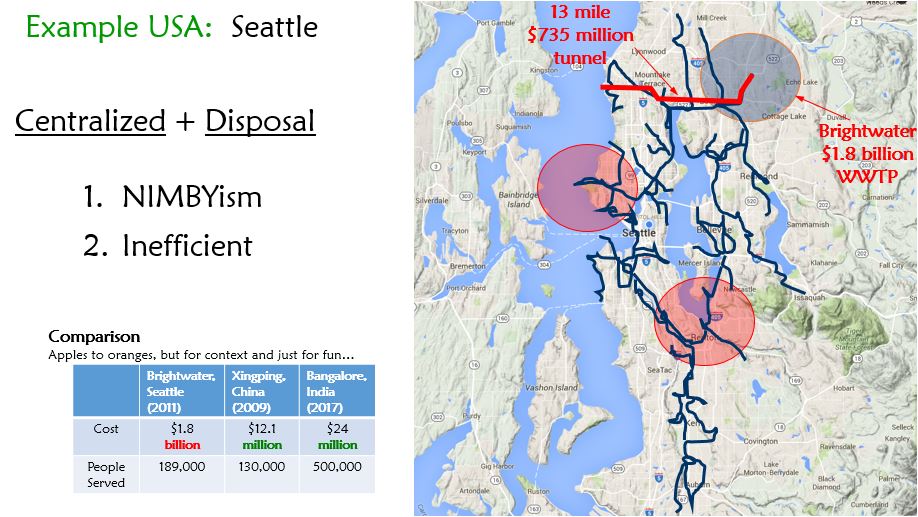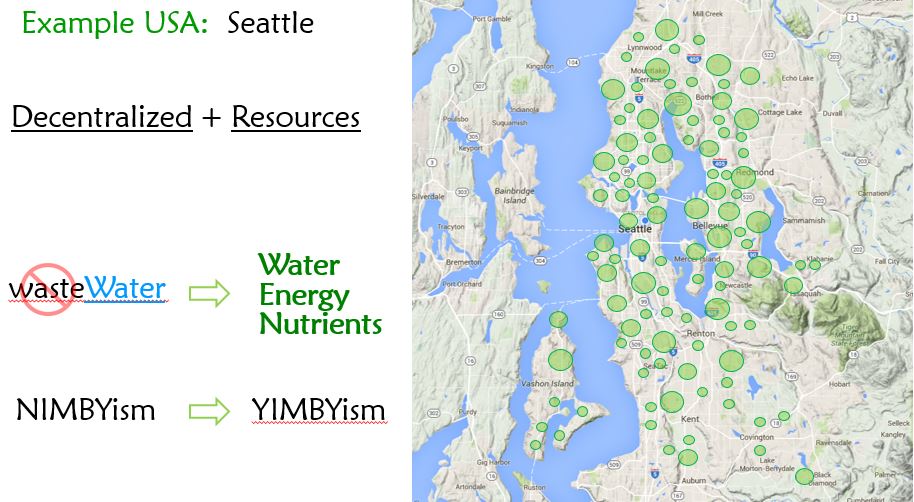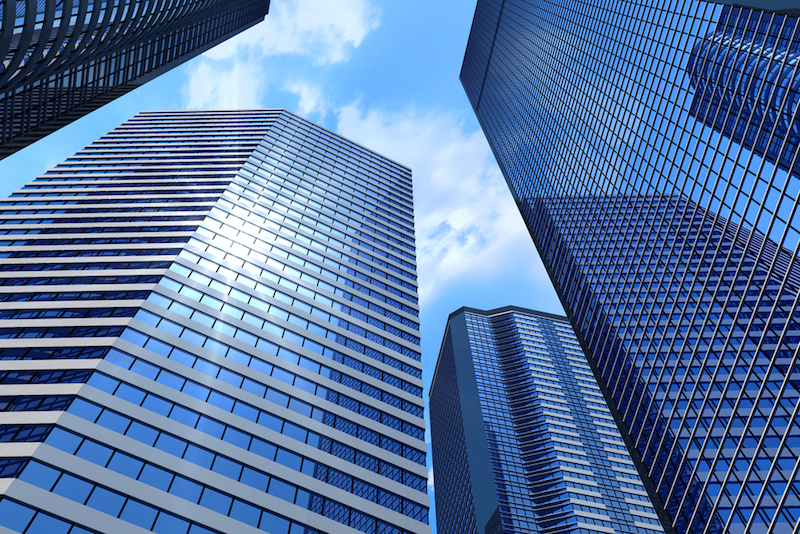Alternative Wastewater Collection & Treatment


Progressive designers, planners and approval authorities are recognizing that centralized collection and treatment of wastewater is not the panacea it has long been assumed to be. Alternative wastewater systems that treat the water where it is used are proving to be less expensive and more sustainable. Green building programs like the LEED Rating System (www.usgbc.org ) and the Living Building Challenge ( www.ilbi.org ) encourage and, in the case of the latter, mandate decentralized treatment and reuse of “waste”water.

Decentralized and distributed solutions for “waste”water treatment and reuse using constructed wetlands.
Decentralized Concept of Wastewater Management
Decentralized solutions that treat wastewater where it is used – and ideally make beneficial local reuse of the resource – have significant advantages for developers, the community and the environment. The decentralized concept of wastewater management urges treating wastewater, then reusing and/or dispersing the reclaimed water, as close to where it is generated as practical. Decentralization produces wastewater systems that cost less, are better neighbors and are more environmentally benign than those produced by conventional engineering. The decentralized concept minimizes investment in an extensive and unnecessary conveyance infrastructure, eliminates much or all of the cost of its maintenance and minimizes the significant public health and environmental liabilities inherent in that conveyance system.
Sewer line extensions can be very expensive and there is an increasing awareness of their indirect costs to the community and the environment. Their expense has generally been underestimated—particularly when including life-cycle cost analysis. As a result, fees charged by communities are increasing. Sewer line extensions have been one of the leading causes of poor land use planning and suburban sprawl. Decentralized systems and comprehensive wastewater policy planning are being recognized as important tools for Smart Growth. Conventional engineering offering “decentralized” approaches that simply replicate for a development a centralized municipal design (central plant and extensive collection) bring with them the same disadvantages in cost, sewer plant NIMBYism and environmental impact.
Conventional wisdom and engineering guidelines have reflected the belief that centralized collection and treatment of wastewater offered the best environmental solution. This is increasingly being questioned by research identifying the true environmental costs of conventional centralized systems. Water is an increasingly precious resource and rapid growth even in non-arid parts of the world is placing a strain on the quality and quantity available. Centralized wastewater systems have the fundamental problem that they often remove water from a location and transport it somewhere else. This robs the local watershed of an important resource and adversely affects the local hydrology. It also takes many small manageable treatment issues and combines them into a single large pollution problem that can be difficult to handle. Sewer lines have also been shown to adversely affect local water tables by acting as a French drain that desiccates the ground, drying up local wells and negatively impacting water quality and the environment.
The decentralized concept of wastewater entails multiple treatment centers distributed throughout the service area. Distribution lends itself to treatment methods such as sand filters (or similar biofiltration technology) and constructed wetlands which are inherently stable with low operational and maintenance requirements. These multiple treatment centers lend themselves to effluent sewer technology (conveyance only of the liquid) for any collection that is needed, thereby reducing again the expense, disruption and maintenance of the overall system.
Treatment of effluent at distributed treatment centers can drastically reduce the cost of beneficial reuse projects, as it minimizes the extent of redistribution infrastructure.
A decentralized concept system may include:
- onsite systems contained entirely within the fee simple boundaries of the lot it serves;
- small-scale collective systems, with their reuse/dispersal sites on easements on the lots served, on vacant lots purchased for this purpose, on off-site properties, or a combination of these;
- larger scale collective systems utilizing dispersed or aggregated reuse/dispersal sites or discharging to surface water.
Any or all of these may be employed within the service area of a single management entity to compose a unified wastewater management system. Further, these concepts may be combined with conventional methods to create a unified system serving the full range of land uses, from low-density residential to urban core. Management of the system would be planned to assure appropriate levels of oversight to each of the system components, as applicable to each situation. The level of collectivization in any given circumstance would be due to such factors as development density, topography, type(s) of development, opportunities for reuse, and availability of appropriate dispersal sites or discharge routes.
Decentralized Scales and Phases to the Need
Perhaps the greatest financial advantage to developers of a decentralized and distributed wastewater concept is its ability to scale to different sizes (from single family to urban densities) and phase to a project’s build out. This allows developers to pay for and implement only the amount of infrastructure that is needed as property is sold and financing becomes more available. Conventional systems generally require that a community or development project incur the full upfront cost of a centralized system at great risk before the need exists. If full build out is not rapidly achieved, not only is the full financial burden of the infrastructure carried by the developer, but the limited flow causes significant difficulties for the operation and maintenance of an inflexible central plant designed for greater loads.
Decentralized wastewater and stormwater solutions provide more options for communities and developers. Solutions exist for a wide range of density levels from single family systems to package plants for urban settings. By treating the water onsite, projects have the option of reclaiming and reusing locally a valuable resource, effectively replacing potable water for uses like irrigation or toilet flushing. Even if no other beneficial reuse is foreseen, decentralized systems can earn credit for recharging local watersheds with high-quality purified water.
Distributed onsite systems save tremendous amounts of money by avoiding the expense of centralized collection. For wastewater, collection to the extent it is needed can be designed to only pump effluent—thereby significantly reducing the economic and environmental costs.
BENEFITS of constructed wetlands and other decentralized biofiltration technologies:
- Scales well— distributed constructed wetlands and other biofiltration treatment can be designed for a wide variety of system sizes and types from single family residences to urban densities, and applications appropriate for residential, institutional, commercial or municipal uses. Large development projects can efficiently be broken down into discrete systems sized and phased for the specific needs.
- Phases well—because the systems are typically distributed and onsite, large upfront costs are avoided by building only as needed when separate phases are financed and ready.
Low installation cost—in contrast to expensive treatment plants consisting of sophisticated and sensitive mechanical equipment, the “treatment plant” of a constructed wetland consists of gravel in a lined, excavated basin planted with indigenous wetland plants. Skilled, local excavators can be readily trained to install. - Low operator costs—because very little maintenance is required, systems typically qualify for the lowest level operator certification levels.
- Little or no energy costs—depending on topology, systems can be entirely passive, driven by gravity and solar energy (plant photosynthesis). If lift stations are needed, reliable low-energy pumps can handle the job.
- Robust—constructed wetlands can handle fluctuating water flows and Whole Water Systems’ patented technology ensures long effective system life. With minimal maintenance, constructed wetland treatment systems should have an indefinite useful life. In twenty years of design and installation by Whole Water System’s principals, no systems have yet failed.
- High-performance treatment—Whole Water’s engineered constructed wetlands and other advanced biofiltration systems provide a high level of purification, qualifying as tertiary treatment by the EPA with reuse for subsurface irrigation.
- Landscaping amenity—contained or subsurface water flow ensures that there is no odor, no mosquitoes, and no possibility of contact with the effluent. Constructed wetland plants can be designed to add visual appeal to a garden or to simply blend into the surroundings. High-end residential clients have featured them prominently amidst expensive and accessible landscaping in close proximity to their homes. One commercial lodging client has even conducted a wedding on their constructed wetland amidst the attractive plants.
Whole Water Systems Experience
The principals at Whole Water Systems are pioneers in decentralized wastewater and stormwater design with over twenty years of experience using constructed wetlands and other advanced biofiltration technology. Many of their systems are in high-elevation cold-climate and/or desert locations, successfully demonstrating the technology in some of the most demanding environments for biologically-based water treatment systems. Two patents have been awarded for advancement of constructed wetland design. In twenty years of design and installation, not a single constructed wetland treatment system has failed or resulted in comments of odor.
Wastewater Projects – Designed by Whole Water Principals
Whole Water’s family of advanced water treatment solutions using biofiltration technology

